We are no longer building saddle trees, but we have two videos about how Western saddles fit horses available on our westernsaddlefit.com website.
Wood Post Horns
We wrote our Basics on Horns page to explain the decisions you can make in choosing the horn you want. These pages are to let you see pictures of some of the combinations of specs you can order. There are three other pages in this section: one for Horns on Wade Trees, one for Wood Post Horns on Swell Fork Trees and a third for Special Wood Post Horns.
This page is for comparison purposes, expanding a bit on our Basics on Horns page. The first table compares forks with varying stock thicknesses so you can see the effect this has on how the horn appears. The second table compares wood post horns on swell forks to Wades, showing the visual effect of the different the top cut angles. The third table compares leaned ahead swell forks to stood up swell forks, illustrating the reason for changing the pitch angle to get the same look.
Please note – these pictures are taken on a flat table. The horns will look flatter when they are on a horse.
Stock Thickness Differences on Wades
Here are Wade horns with as similar specs as we had pictures of but with stock thicknesses ranging from 4 ¼” to 5 ½”. All the specs are labeled beneath the pictures, so this should give you a good idea on how stock thickness affects the look of the horn.
 |
 |
| 4 1/4" stock thickness 3" high, 4" cap, 27 degree pitch |
4 1/2" stock thickness 3 1/4" high, 4" cap, 30 degree pitch |
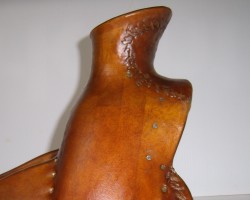 |
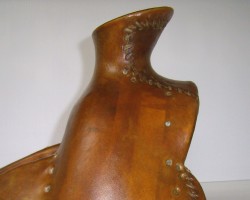 |
| 4 3/4" stock thickness 3 1/4" high, 4" cap, 27 degree pitch |
5" stock thickness 3 1/4" high, 4" cap, 27 degree pitch |
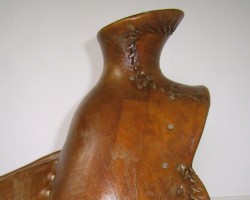 |
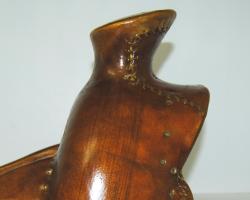 |
| 5 1/4" stock thickness 3 1/4" high, 4" cap, 27 degree pitch |
5 1/2" stock thickness 3 1/4" high, 4" cap, 27 degree pitch |
Stock Thickness Differences on Wood Post Swell Forks
These are wood post horns on swell forks with stock thicknesses ranging from 4 ¼” to 5”. You can see the differences in top cut angle as the forks get thicker.
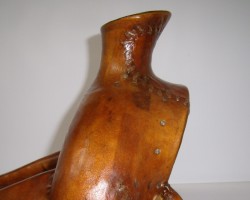 |
 |
| 4 1/4" stock thickness 3" high, 3 1/4" cap, 24 degree pitch |
4 1/2" stock thickness 3" high, 3 1/4" cap, 24 degree pitch |
 |
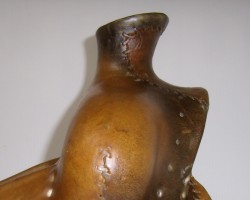 |
| 4 3/4" stock thickness 3" high, 3 1/4" cap, 24 degree pitch |
5" stock thickness 3" high, 3 1/4" cap, 24 degree pitch |
Comparing Wades and Wood Post Swell Fork Horns
The top cut angle on swell fork trees is lower than on Wade trees, which means the lip slopes down more on swell forks than on Wades. Therefore horns that measure the same at the front will be shorter at the back on swell forks than on Wades, and horns also appear to have more pitch on swell forks because the greater disparity between the top cut angle and the horn pitch angle. This is why we rarely put a 30 degree pitch on swell forks, though it can easily be done.
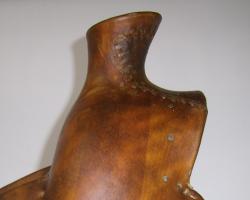 |
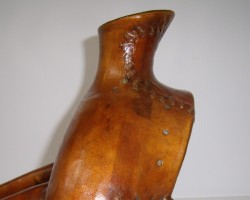 |
| Wade fork 24 degree pitch 3" high, 3 1/4" cap, 5" stock |
Swell fork 24 degree pitch 3" high, 3 1/4" cap, 4 1/4" stock |
 |
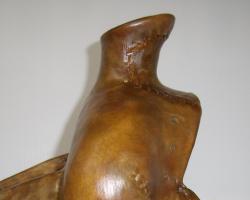 |
| Wade fork 27 degree pitch 3" high, 3 1/4" cap, 5" stock |
Swell fork 27 degree pitch 3" high, 3 1/4" cap, 4 1/4" stock |
 |
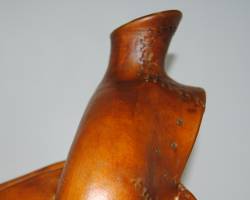 |
| Wade fork 30 degree pitch 3" high, 3 1/4" cap, 5" stock |
Swell fork 30 degree pitch 3" high, 3 1/4" cap, 4 1/4" stock |
Comparing Leaned Ahead to Stood Up Swell Fork Wood Post Horns
Because the pitch of the horn is measured against the back of the fork, when you stand up a fork, you also increase the pitch of the horn the same amount. This works out to about 5 degrees on our trees. Therefore, a 19 degree pitch on a stood up fork is the same as a 24 degree pitch on a leaned ahead fork, and a 22 degree pitch on a stood up fork is the same as a 27 degree pitch on a leaned ahead horn.
 |
 |
| Leaned ahead swell fork 24 degree pitch 3" high, 3 1/2" cap, 4 1/2" stock |
Stood up swell fork 19 degree pitch 3" high, 3 1/2" cap, 4 1/2" stock |
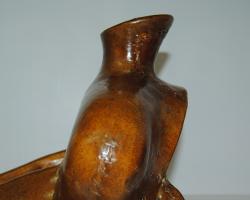 |
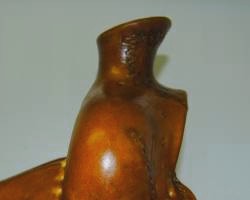 |
| Leaned ahead swell fork 27 degree pitch 3" high, 3 1/2" cap, 4 1/4" stock |
Stood up swell fork 22 degree pitch 3" high, 3 1/2" cap, 4 1/4" stock |
